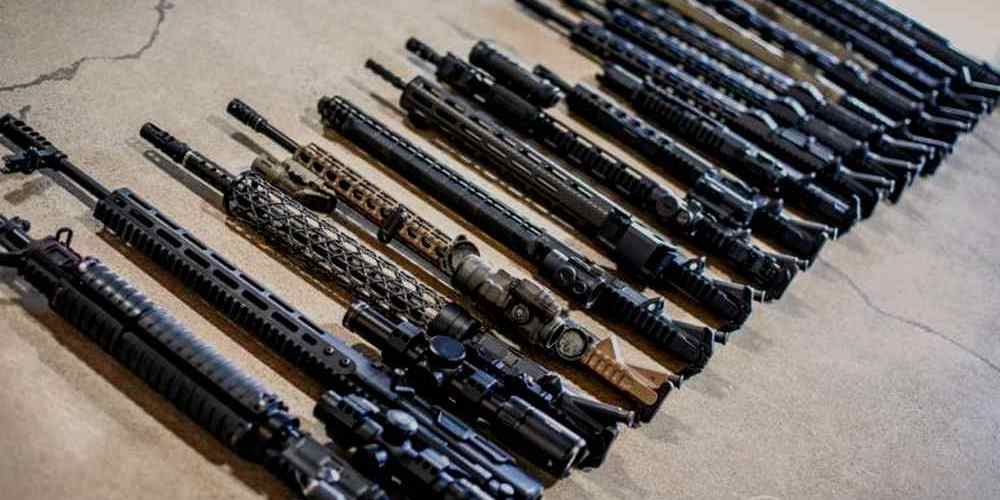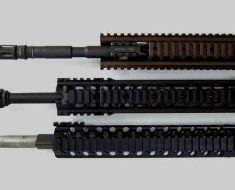“Rail Systems Reviewed: Enhancing Your Tactical Setup with the Perfect Handguard”
Key Considerations When Selecting a Handguard for Tactical Accessories
When it comes to outfitting your rail system with tactical accessories, choosing the right handguard is crucial. The handguard serves as the foundation for mounting accessories such as lights, lasers, grips, and more. With so many options available on the market, it can be overwhelming to decide which handguard is best suited for your needs. In this article, we will review some key considerations to keep in mind when selecting a handguard for your rail system.
One of the first things to consider when choosing a handguard is the type of rail system you have. There are several different types of rail systems, including Picatinny, KeyMod, and M-LOK. Each type of rail system has its own set of advantages and disadvantages, so it’s important to choose a handguard that is compatible with your specific rail system.
Another important consideration is the length of the handguard. The length of the handguard will determine how many accessories you can mount on your rail system. If you plan on mounting multiple accessories, you may want to opt for a longer handguard to provide more real estate for mounting options. On the other hand, if you prefer a more streamlined look, a shorter handguard may be more suitable.
Weight is also an important factor to consider when selecting a handguard. A heavier handguard can affect the balance and maneuverability of your firearm, especially if you plan on using it for extended periods of time. Lightweight handguards are often preferred for their ease of handling and reduced fatigue during use.
Material is another key consideration when choosing a handguard. Handguards are typically made from aluminum, polymer, or carbon fiber. Aluminum handguards are durable and provide excellent heat dissipation, but they can be heavier than polymer or carbon fiber handguards. Polymer handguards are lightweight and affordable, but may not be as durable as aluminum. Carbon fiber handguards are lightweight and strong, but they can be more expensive than other materials.
When selecting a handguard for your rail system, it’s important to consider the ergonomics of the handguard. A comfortable handguard can make a significant difference in your shooting experience, especially during long shooting sessions. Look for handguards with a comfortable grip and smooth edges to prevent discomfort or irritation during use.
Finally, consider the aesthetics of the handguard. While functionality should be your primary concern, the appearance of the handguard can also play a role in your decision-making process. Choose a handguard that complements the overall look of your firearm and reflects your personal style.
In conclusion, selecting the right handguard for your rail system is a decision that should not be taken lightly. Consider factors such as rail system compatibility, length, weight, material, ergonomics, and aesthetics when making your decision. By taking the time to research and evaluate your options, you can ensure that you choose a handguard that meets your needs and enhances your shooting experience.

Top Handguard Options for Rail Systems
When it comes to customizing your firearm for tactical use, choosing the right handguard for your rail system is crucial. The handguard not only provides a comfortable grip for shooting, but it also serves as a platform for attaching various accessories such as lights, lasers, grips, and bipods. With so many options available on the market, it can be overwhelming to decide which handguard is best suited for your needs. In this article, we will review some of the top handguard options for rail systems to help you make an informed decision.
One popular choice among gun enthusiasts is the free-floating handguard. This type of handguard attaches to the rifle without touching the barrel, allowing for increased accuracy and better heat dissipation. Free-floating handguards come in a variety of lengths and styles, making them versatile for different shooting applications. They are also lightweight and easy to install, making them a favorite among shooters who value performance and customization.
Another option to consider is the quad rail handguard. Quad rails feature four rails on all sides of the handguard, providing ample space for attaching multiple accessories. This type of handguard is ideal for shooters who require a high level of customization and prefer to have all their tactical gear within easy reach. While quad rails can add weight to the rifle, they offer unparalleled versatility and functionality for those who need it.
For shooters looking for a more streamlined and lightweight option, the M-LOK handguard is a popular choice. M-LOK handguards feature a series of slots that allow for easy attachment of accessories without the need for bulky rail sections. This design reduces weight and bulk while still providing ample space for customization. M-LOK handguards are compatible with a wide range of accessories, making them a versatile option for shooters who value simplicity and efficiency.
If you prefer a more traditional look, the drop-in handguard may be the right choice for you. Drop-in handguards are easy to install and provide a classic aesthetic to your rifle. While they may not offer as much customization as other handguard options, drop-in handguards are reliable and functional for most shooting applications. They are also typically more affordable than other types of handguards, making them a budget-friendly option for shooters on a tight budget.
Ultimately, the best handguard for your rail system will depend on your personal preferences and shooting needs. Consider factors such as weight, customization options, and budget when choosing a handguard for your rifle. Whether you opt for a free-floating handguard for precision shooting or a quad rail for maximum customization, selecting the right handguard will enhance your shooting experience and help you get the most out of your firearm. Take the time to research and compare different handguard options to find the perfect fit for your tactical accessories.
How to Install and Maintain Your Handguard for Optimal Performance
When it comes to upgrading your rail system for tactical accessories, choosing the right handguard is crucial. The handguard not only provides a platform for mounting accessories such as lights, lasers, and grips, but it also protects your hands from the heat generated by the barrel during extended firing sessions. With so many options available on the market, it can be overwhelming to decide which handguard is best suited for your needs. In this article, we will review some key factors to consider when selecting a handguard and provide tips on how to install and maintain it for optimal performance.
One of the first things to consider when choosing a handguard is the material it is made from. Handguards are typically constructed from aluminum, polymer, or carbon fiber. Aluminum handguards are durable and provide excellent heat dissipation, making them a popular choice among shooters. Polymer handguards are lightweight and affordable, but may not offer the same level of heat resistance as aluminum. Carbon fiber handguards are the lightest option available and offer superior heat resistance, but they tend to be more expensive.
Another important factor to consider is the length of the handguard. Handguards come in various lengths, ranging from carbine-length to rifle-length. The length of the handguard will determine how many accessories you can mount on it and how much rail space you have available. If you plan on mounting multiple accessories, a longer handguard may be more suitable for your needs. However, if you prefer a more compact setup, a shorter handguard may be the better option.
Once you have selected a handguard that meets your needs, it is important to properly install and maintain it to ensure optimal performance. The first step in installing a handguard is to remove the existing handguard from your rifle. This can typically be done by loosening the screws or bolts that secure the handguard to the barrel nut. Once the old handguard is removed, you can then attach the new handguard to the barrel nut using the provided mounting hardware.
After installing the handguard, it is important to regularly inspect and maintain it to ensure it is functioning properly. This includes checking for any signs of wear or damage, such as cracks or dents, and ensuring that all mounting hardware is secure. It is also recommended to clean the handguard regularly to remove any dirt, debris, or residue that may accumulate over time. This can be done using a soft brush or cloth and a mild cleaning solution.
In conclusion, choosing the right handguard for your rail system is essential for maximizing the performance of your tactical accessories. By considering factors such as material, length, and installation, you can select a handguard that meets your needs and preferences. Additionally, by properly installing and maintaining your handguard, you can ensure it continues to function optimally for years to come. So, take the time to research and select the best handguard for your setup, and enjoy the benefits of a well-equipped rail system.
Comparing Different Handguard Materials and Designs
When it comes to choosing the right handguard for your rail system, there are a variety of factors to consider. One of the most important decisions you’ll need to make is what material you want your handguard to be made of. Different materials offer different benefits and drawbacks, so it’s important to understand the differences before making a decision.
One of the most common materials used for handguards is aluminum. Aluminum handguards are lightweight and durable, making them a popular choice for many shooters. They are also relatively inexpensive compared to other materials, making them a great option for those on a budget. However, aluminum handguards can get hot to the touch after extended use, so it’s important to consider this if you plan on using your rifle for long periods of time.
Another popular material for handguards is polymer. Polymer handguards are lightweight and affordable, making them a great option for those looking for a budget-friendly option. They also tend to stay cooler to the touch than aluminum handguards, making them a good choice for those who plan on using their rifle for extended periods of time. However, polymer handguards are not as durable as aluminum handguards, so they may not be the best option for those who plan on putting their rifle through heavy use.
Carbon fiber handguards are another option to consider. Carbon fiber handguards are extremely lightweight and durable, making them a popular choice for those looking for a high-performance option. They also tend to stay cooler to the touch than aluminum handguards, making them a good choice for those who plan on using their rifle for extended periods of time. However, carbon fiber handguards can be more expensive than other materials, so they may not be the best option for those on a budget.
When it comes to handguard designs, there are also a variety of options to consider. One popular design is the free-floating handguard. Free-floating handguards do not come into contact with the barrel of the rifle, which can help improve accuracy by reducing barrel harmonics. They also tend to be more lightweight than traditional handguards, making them a popular choice for those looking to reduce the overall weight of their rifle.
Another popular handguard design is the quad rail handguard. Quad rail handguards feature four rails that allow for the attachment of a variety of accessories, such as lights, lasers, and grips. This can be a great option for those looking to customize their rifle with a variety of tactical accessories. However, quad rail handguards tend to be heavier than other handguard designs, so they may not be the best option for those looking to reduce the overall weight of their rifle.
In conclusion, when choosing the right handguard for your rail system, it’s important to consider both the material and design of the handguard. Aluminum handguards are lightweight and durable, while polymer handguards are affordable and stay cooler to the touch. Carbon fiber handguards are extremely lightweight and durable, but can be more expensive. Free-floating handguards can help improve accuracy, while quad rail handguards allow for the attachment of a variety of accessories. By considering these factors, you can choose the right handguard for your tactical accessories and improve the overall performance of your rifle.
Enhancing Your Rail System with Customized Handguard Accessories
When it comes to enhancing your rail system with customized handguard accessories, choosing the right handguard is crucial. Handguards play a vital role in providing a stable platform for mounting tactical accessories such as lights, lasers, grips, and bipods. With so many options available on the market, it can be overwhelming to decide which handguard is best suited for your needs. In this article, we will review some of the key factors to consider when selecting a handguard for your rail system.
One of the first things to consider when choosing a handguard is the material it is made from. Handguards are typically constructed from aluminum, polymer, or carbon fiber. Aluminum handguards are known for their durability and strength, making them a popular choice among tactical shooters. Polymer handguards are lightweight and affordable, but may not be as durable as aluminum. Carbon fiber handguards are extremely lightweight and strong, but tend to be more expensive than other materials.
Another important factor to consider is the length of the handguard. Handguards come in various lengths, ranging from carbine-length to rifle-length. The length of the handguard will determine how much rail space is available for mounting accessories. If you plan on mounting multiple accessories, a longer handguard may be necessary to accommodate them all. However, if you prefer a more compact setup, a shorter handguard may be more suitable.
In addition to material and length, it is also important to consider the type of rail system your handguard is compatible with. Most handguards are designed to be compatible with either KeyMod or M-LOK rail systems. KeyMod handguards feature keyhole-shaped slots for mounting accessories, while M-LOK handguards feature rectangular slots. It is important to choose a handguard that is compatible with your rail system to ensure a secure and stable mounting platform for your accessories.
When selecting a handguard, it is also important to consider the weight and ergonomics of the handguard. A heavy handguard can add unnecessary weight to your rifle, making it more difficult to maneuver and handle. Look for a handguard that is lightweight yet durable to ensure optimal performance. Additionally, consider the shape and design of the handguard to ensure a comfortable grip and ergonomic feel.
Finally, consider the aesthetics of the handguard. While functionality is key, the appearance of the handguard can also play a role in your decision-making process. Choose a handguard that complements the overall look of your rifle and reflects your personal style.
In conclusion, choosing the right handguard for your rail system is essential for maximizing the performance and functionality of your tactical accessories. Consider factors such as material, length, compatibility, weight, ergonomics, and aesthetics when selecting a handguard. By taking the time to research and evaluate your options, you can find a handguard that meets your needs and enhances your shooting experience.




